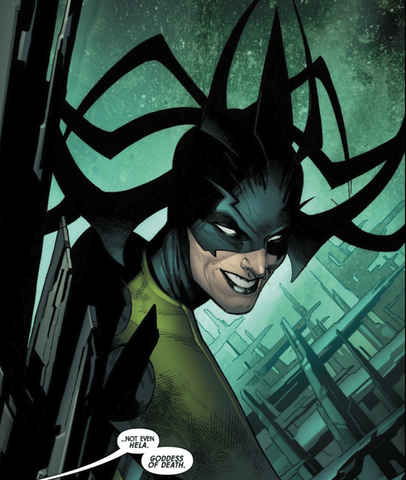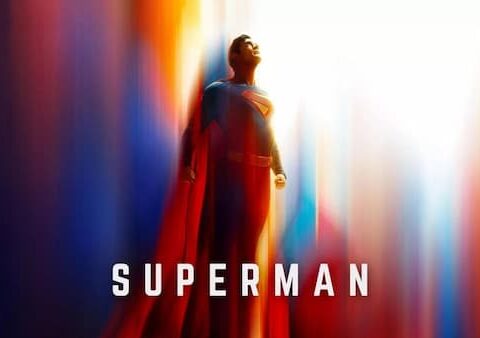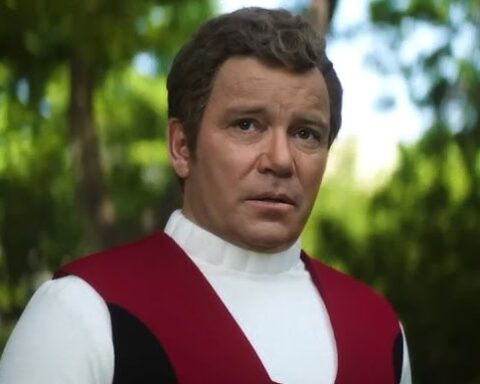I’ve had a mixed relationship with Guardians of the Galaxy books for a few years (see my review of the All-New Guardians of the Galaxy series here): no GOTG run since the Brian Michael Bendis era seems to have found that kind of quality or consistency.
This new series, written by Donny Cates, is – in that sense – promising.
There’s a lot going on here, somewhat in the aftermath of the Infinity Wars story – and the opening arc boasts top-quality storytelling and an engaging premise.
GOTG #1 opens in sublime, slightly offbeat, form, with a gathering of pretty much every character in the vast Marvel cosmic universe (everyone from the Silver Surfer to the Starjammers and Howard the Duck): all gathered by Eros/Starfox to discuss an urgent matter.
This whole sequence, terrifically coloured and illustrated, has a mixture of surreal and compelling that makes it difficult to not keep re-reading it: in particular, the way Thanos’s headless body is simply there the whole time, while Starfox is addressing the gathering.
A recording of Thanos is played to those gathered – clearly recorded to be played in the event of the Titan’s death. A gloating, smug Thanos tells the audience that his consciousness has been uploaded into the body of another being – this was always his plan in the event of his death. But he doesn’t tell them who it is.
Eros has narrowed down a list of likely or logical candidates: but he specifies one particular candidate who should be targeted (and killed) before anyone else – Gamora.
It’s good to see Thanos continuing to inspire fear and panic even after he’s dead. It’s also interesting to see a darker, more cut-throat Starfox than we’re used to here, due to the circumstances.
The paranoia spreads immediately: anyone – including anyone even in this gathering – could be the being Thanos put his consciousness into. You could just imagine the pleasure the Mad Titan would take in seeing all of these characters break down into suspicion and paranoia of each other – and all on account of fear of him.
Elsewhere, Quill and Groot are all that’s left of the Guardians of the Galaxy. The Milano is gone and now we see a drunk, despondent Quill and a moody, unfriendly Groot getting on each other’s nerves aboard the Ryder. This side of things is less interesting: but both A and B stories are ultimately headed for a collision anyway.
The Black Order attacks Eros’s party, stealing Thanos’s headless corpse and apparently decimating most of the characters Starfox had gathered together.
The few (apparent) survivors are come upon by Quill and Groot aboard the Ryder, who rescue them. In order to protect these survivors from the Nova Corps, Quill adopts them as his new team… Beta Ray Bill, Phylla-Vell, Moondragon, and Cosmic Ghost Rider.
Meanwhile, we see Proxima Midnight and the Black Order take Thanos’s body back to the mysterious mastermind of this plot: who we learn is none other than Hela, the goddess of death.
Good twist there – and the dramatic visual reveal of Hela at the end is a stunning piece of art.

This opening installment is also full of nice touches. It’s good to see Moondragon defending Gamora and objecting to her murder: because, although it isn’t mentioned here, one assumes it’s because of their history (I’m particularly thinking all the way back to the Warlock & the Infinity Watch days, where Moondragon and Gamora were team-mates).
It’s also great how we see the two strands of events – one being Quill and Groot on the Ryder, the other being Starfox’s illustrious gathering – happening separately and then coming together at the end.
In general, this is very rich set-up, showcasing good storytelling; as well as superb artwork and colors, courtesy of Geoff Shaw and Marte Gracia.
I love that GOTG #2 opens with Quill having a long-distance conversation with Kitty Pryde. The dialogue is fun, but more importantly it demonstrates the writers’ attention to character history and connections.
Quill is traumatised by Gamora’s killing him (during the Infinity Wars event: reviewed here) and is having flashbacks.
Hela and the Black Order, meanwhile, are hunting for Thanos’s head: while we also learn that some of the characters have survived the Black Order attack and we find Starfox alive, having been rescued by Gladiator and co. Also present are Nebula and various others. Their intent is still entirely to stop Thanos from being resurrected in a new body: and to find and kill Gamora.
Starfox, however, has been badly injured and disfigured: he now looks like a cross between Two-Face from the Batman books and the crippled Christopher Pike from Star Trek: The Original Series… which is a bit weird, but I’m finding this new characterisation of Eros interesting.
This is sharply brought into focus in GOTG #3, where we start with a moody, tense scene of Eros brooding before the giant hologram of Thanos and airing his grievances, even baring his soul, to the responseless and inanimate representation of the Mad Titan.
This is such a dark, brooding scene: with Eros, with his scarred face and in his wheelchair, addressing this facsimile of his dead brother and seeming more and more unhinged the longer he goes on.
The way this scene is ‘lit’ is also fascinating, reflecting the mood and subject.
Meanwhile, Hela and the Black Order track Thanos’s missing head to Annihilus… where we find the Titan’s severed head being kicked around like a football by Annihilus’s hordes.
At the same time, Gladiator, Nebula and co have tracked down Richard Ryder: after attacking him, they let him go, hoping he will unintentionally lead them to Starlord (and thus to Gamora). Meanwhile, Quill and his new ‘Guardians’ team is having a bad time of it: Quill is still drinking and unstable, prompting Groot to stage a mutiny and declare himself captain – supported by Beta Ray Bill and the rest of the team.
With Quill no longer having any say in the matter, the team heads to Gamora’s suspected location – and this complex plot continues to accelerate at a compelling pace.
In GOTG #4, the whole hunt for Gamora thing comes to a head: Groot, Quill and co track down Gamora on Halfworld… only to be followed by Richard Ryder and then Gladiator and the group that wants to kill Gamora.
We inevitably then get a showdown on the planet, which isn’t that interesting. But some of the character work here is good: Gamora’s and Peter’s confused and downbeat reactions to each other or Groot’s undisguised (and reciprocated) affection for Gamora, for example.
As GOTG #5 begins, we find that Gamora has been taken by Gladiator and the others.
Quill and co are left on the planet, wondering what to do next. Beta Ray Bill calls upon the services of Lockjaw (the Inhumans’ transporter-dog) to aid them.
On board the Shiar flagship, Gamora is dragged before Starfox as the group prepares to do the deed and execute her. It’s grim stuff, seeing how willing everyone is to carry out this execution: but it’s a nice touch to see Eros be the one to show respect for his niece and to be the one not deriving any kind of pleasure out of having to do this.
At any rate, it’s at this point that Hela intrudes into the party. And we discover that she isn’t interested in Gamora at all: because the person Thanos’s consciousness is meant to inhabit is not Gamora, but Eros. It’s been Eros all along.
There’s something very tragic about seeing Eros realise this… and to then be helpless to stop it. After all we’ve seen Eros do, after all his desperation to stop Thanos’s resurrection… it’s kind of heartbreaking to watch him realise he is the chosen vehicle for Thanos’s survival.
By the time Quill and the others reach Gamora, Hela and Eros have gone. And the plan is for Eros merely to carry Thanos’s consciousness to where Thanos’s reformed body is waiting (we see Hela has reattached Thanos’s head to his corpse), at which point the consciosuness will be transferred back to the original host (and, presumably, Eros will die).
GOTG #6 wastes no time: Quill and the others go straight to where Hela is and attack, hoping to stop Thanos’s resurrection. In short, they succeed – somewhat bafflingly easily.
It’s an anti-climax, given the quality of all the build-up: but, hey, were we really expecting better?
In effect, Hela’s plan is thwarted and Thanos is not restored: but it requires Gamora to murder her uncle, Eros, before the consciousness transfer can be completed.
Gamora’s exchange with a dying Eros is probably the highlight of the book: and I’m sad to see Eros pay the price for this whole nightmare. But the conclusion to this rather epic story is a letdown, lacking all of the qualities of the earlier chapters.
It’s questionable to see someone on the power-level of Hela be defeated this easily: and it really does feel like an anti-climatic hatchet job of a finale.
I still really enjoyed the opening couple of installments (especially Guardians of the Galaxy #1); but I had hoped for a better end-game than this. There’s a distinct lack of any meaningful mourning for Eros by anyone. Hela and the Black Order just disappear from the story, with no real sense of what their situation is.
And there’s very little fall-out between characters regarding their recent actions: Gladiator is shown, for example, sat with Gamora, Quill and co at the end, and yet he tried to execute her in the previous chapter.
It’s messy and unsatisfying.
At the end of it, we see most of the characters part ways – except for Bill, Moondragon and Phylla-Vell, who are staying on as Guardians of the Galaxy. Which is cool – it seems like Moondragon’s natural place, certainly.
Gamora is also back; and the question now is what the deal is going to be with the absent Rocket Raccoon.
The unsatisfying nature of this arc’s finale doesn’t entirely make these opening six installments a waste: it’s still a very enjoyable arc to read, aided as it is by excellent visual quality and visual language.
And that alone is suggestive of this series potentially being able to maintain a strong quality level going forward.
–




